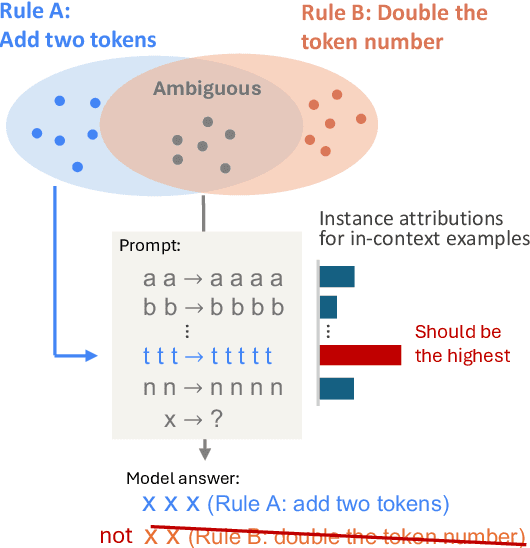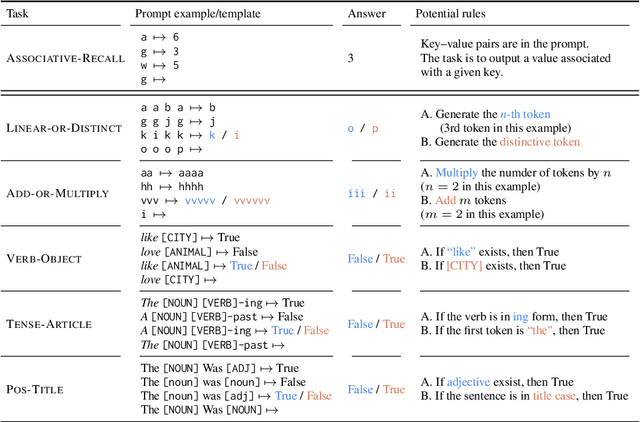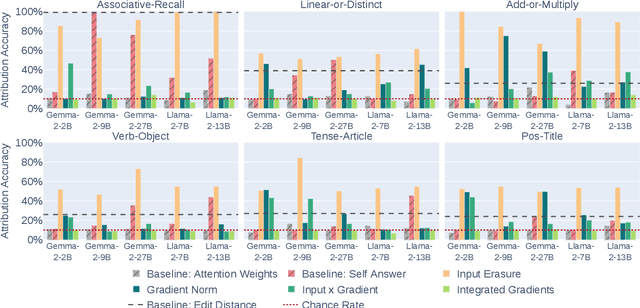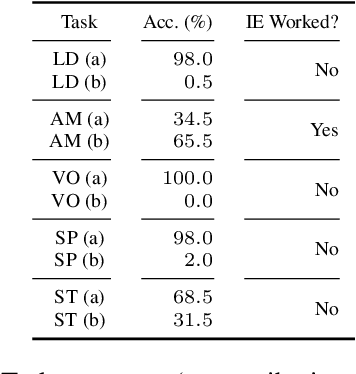Jun Suzuki
VDocRAG: Retrieval-Augmented Generation over Visually-Rich Documents
Apr 14, 2025Abstract:We aim to develop a retrieval-augmented generation (RAG) framework that answers questions over a corpus of visually-rich documents presented in mixed modalities (e.g., charts, tables) and diverse formats (e.g., PDF, PPTX). In this paper, we introduce a new RAG framework, VDocRAG, which can directly understand varied documents and modalities in a unified image format to prevent missing information that occurs by parsing documents to obtain text. To improve the performance, we propose novel self-supervised pre-training tasks that adapt large vision-language models for retrieval by compressing visual information into dense token representations while aligning them with textual content in documents. Furthermore, we introduce OpenDocVQA, the first unified collection of open-domain document visual question answering datasets, encompassing diverse document types and formats. OpenDocVQA provides a comprehensive resource for training and evaluating retrieval and question answering models on visually-rich documents in an open-domain setting. Experiments show that VDocRAG substantially outperforms conventional text-based RAG and has strong generalization capability, highlighting the potential of an effective RAG paradigm for real-world documents.
STEP: Staged Parameter-Efficient Pre-training for Large Language Models
Apr 05, 2025Abstract:Pre-training large language models (LLMs) faces significant memory challenges due to the large size of model parameters. We introduce STaged parameter-Efficient Pre-training (STEP), which integrates parameter-efficient tuning techniques with model growth. We conduct experiments on pre-training LLMs of various sizes and demonstrate that STEP achieves up to a 53.9% reduction in maximum memory requirements compared to vanilla pre-training while maintaining equivalent performance. Furthermore, we show that the model by STEP performs comparably to vanilla pre-trained models on downstream tasks after instruction tuning.
Efficient Construction of Model Family through Progressive Training Using Model Expansion
Apr 01, 2025Abstract:As Large Language Models (LLMs) gain widespread practical application, providing the model family of different parameter sizes has become standard practice to address diverse computational requirements. Conventionally, each model in a family is trained independently, resulting in computational costs that scale additively with the number of models. We propose an efficient method for constructing the model family through progressive training, where smaller models are incrementally expanded to larger sizes to create a complete model family. Through extensive experiments with a model family ranging from 1B to 8B parameters, we demonstrate that our method reduces computational costs by approximately 25% while maintaining comparable performance to independently trained models. Furthermore, by strategically adjusting maximum learning rates based on model size, our method outperforms the independent training across various metrics. Beyond performance gains, our approach offers an additional advantage: models in our family tend to yield more consistent behavior across different model sizes.
Drop-Upcycling: Training Sparse Mixture of Experts with Partial Re-initialization
Feb 26, 2025Abstract:The Mixture of Experts (MoE) architecture reduces the training and inference cost significantly compared to a dense model of equivalent capacity. Upcycling is an approach that initializes and trains an MoE model using a pre-trained dense model. While upcycling leads to initial performance gains, the training progresses slower than when trained from scratch, leading to suboptimal performance in the long term. We propose Drop-Upcycling - a method that effectively addresses this problem. Drop-Upcycling combines two seemingly contradictory approaches: utilizing the knowledge of pre-trained dense models while statistically re-initializing some parts of the weights. This approach strategically promotes expert specialization, significantly enhancing the MoE model's efficiency in knowledge acquisition. Extensive large-scale experiments demonstrate that Drop-Upcycling significantly outperforms previous MoE construction methods in the long term, specifically when training on hundreds of billions of tokens or more. As a result, our MoE model with 5.9B active parameters achieves comparable performance to a 13B dense model in the same model family, while requiring approximately 1/4 of the training FLOPs. All experimental resources, including source code, training data, model checkpoints and logs, are publicly available to promote reproducibility and future research on MoE.
Reference-free Evaluation Metrics for Text Generation: A Survey
Jan 21, 2025Abstract:A number of automatic evaluation metrics have been proposed for natural language generation systems. The most common approach to automatic evaluation is the use of a reference-based metric that compares the model's output with gold-standard references written by humans. However, it is expensive to create such references, and for some tasks, such as response generation in dialogue, creating references is not a simple matter. Therefore, various reference-free metrics have been developed in recent years. In this survey, which intends to cover the full breadth of all NLG tasks, we investigate the most commonly used approaches, their application, and their other uses beyond evaluating models. The survey concludes by highlighting some promising directions for future research.
Can Input Attributions Interpret the Inductive Reasoning Process Elicited in In-Context Learning?
Dec 20, 2024



Abstract:Elucidating the rationale behind neural models' outputs has been challenging in the machine learning field, which is indeed applicable in this age of large language models (LLMs) and in-context learning (ICL). When it comes to estimating input attributions (IA), ICL poses a new issue of interpreting which example in the prompt, consisting of a set of examples, contributed to identifying the task/rule to be solved. To this end, in this paper, we introduce synthetic diagnostic tasks inspired by the poverty of the stimulus design in inductive reasoning; here, most in-context examples are ambiguous w.r.t. their underlying rule, and one critical example disambiguates the task demonstrated. The question is whether conventional IA methods can identify such an example in interpreting the inductive reasoning process in ICL. Our experiments provide several practical findings; for example, a certain simple IA method works the best, and the larger the model, the generally harder it is to interpret the ICL with gradient-based IA methods.
Pruning Multilingual Large Language Models for Multilingual Inference
Sep 25, 2024Abstract:Multilingual large language models (MLLMs), trained on multilingual balanced data, demonstrate better zero-shot learning performance in non-English languages compared to large language models trained on English-dominant data. However, the disparity in performance between English and non-English languages remains a challenge yet to be fully addressed. A distinctive characteristic of MLLMs is their high-quality translation capabilities, indicating an acquired proficiency in aligning between languages. This study explores how to enhance the zero-shot performance of MLLMs in non-English languages by leveraging their alignment capability between English and non-English languages. To achieve this, we first analyze the behavior of MLLMs when performing translation and reveal that there are large magnitude features that play a critical role in the translation process. Inspired by these findings, we retain the weights associated with operations involving the large magnitude features and prune other weights to force MLLMs to rely on these features for tasks beyond translation. We empirically demonstrate that this pruning strategy can enhance the MLLMs' performance in non-English language.
MQM-Chat: Multidimensional Quality Metrics for Chat Translation
Aug 29, 2024Abstract:The complexities of chats pose significant challenges for machine translation models. Recognizing the need for a precise evaluation metric to address the issues of chat translation, this study introduces Multidimensional Quality Metrics for Chat Translation (MQM-Chat). Through the experiments of five models using MQM-Chat, we observed that all models generated certain fundamental errors, while each of them has different shortcomings, such as omission, overly correcting ambiguous source content, and buzzword issues, resulting in the loss of stylized information. Our findings underscore the effectiveness of MQM-Chat in evaluating chat translation, emphasizing the importance of stylized content and dialogue consistency for future studies.
An Investigation of Warning Erroneous Chat Translations in Cross-lingual Communication
Aug 28, 2024



Abstract:The complexities of chats pose significant challenges for machine translation models. Recognizing the need for a precise evaluation metric to address the issues of chat translation, this study introduces Multidimensional Quality Metrics for Chat Translation (MQM-Chat). Through the experiments of five models using MQM-Chat, we observed that all models generated certain fundamental errors, while each of them has different shortcomings, such as omission, overly correcting ambiguous source content, and buzzword issues, resulting in the loss of stylized information. Our findings underscore the effectiveness of MQM-Chat in evaluating chat translation, emphasizing the importance of stylized content and dialogue consistency for future studies.
Empirical Analysis of Large Vision-Language Models against Goal Hijacking via Visual Prompt Injection
Aug 07, 2024Abstract:We explore visual prompt injection (VPI) that maliciously exploits the ability of large vision-language models (LVLMs) to follow instructions drawn onto the input image. We propose a new VPI method, "goal hijacking via visual prompt injection" (GHVPI), that swaps the execution task of LVLMs from an original task to an alternative task designated by an attacker. The quantitative analysis indicates that GPT-4V is vulnerable to the GHVPI and demonstrates a notable attack success rate of 15.8%, which is an unignorable security risk. Our analysis also shows that successful GHVPI requires high character recognition capability and instruction-following ability in LVLMs.
 Add to Chrome
Add to Chrome Add to Firefox
Add to Firefox Add to Edge
Add to Edge